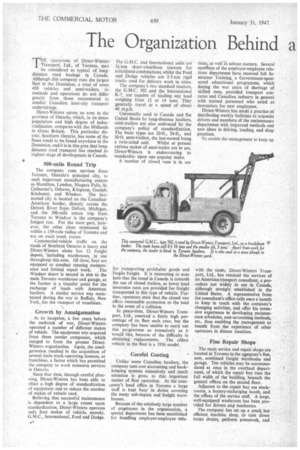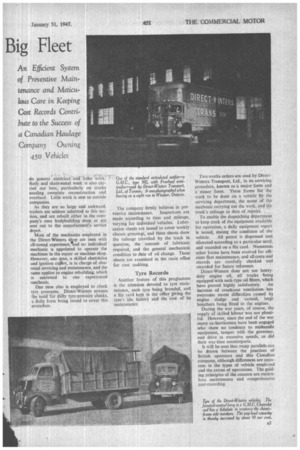The Organization Behind a Big Fleet
Page 36

Page 37

If you've noticed an error in this article please click here to report it so we can fix it.
• THE operations of Direct-Winters
Transport, Ltd., of Toronto, may be considered as typical of longdistance road haulage in Canada. Although this company runs the largest fleet in the Dominion, a total of some 450 vehicles and semi-trailers, its methods and operations do not differ greatly from those encountered in smaller Canadian inter-city transport undertakings.
Direct-Winters serves an area in the province of Ontario, which, in its dense • population and high degree of industrialization. compares with the Midlands in Great Britain. This particular district, Southern Ontario, has some of the finest roads to be found anywhere in the Dominion, and it is in this rea that longdistance road transport has reached its highest stage of development in Canada.
500-mile Round Trip
The company runs services from Toronto, Ontario's principal city, to such important manufacturing centres as Hamilton, London, Niagara Falls, St. Catharine's, Oshawa, Kingston, Guelph, Kitchener, and Windsor. The lastnamed city is located on the CanadianAmerican border, directly across the Detroit River from Detroit, Michigan, and the 500-mile return trip from Toronto to Windsor is the company's longest run. For the most part, however, the other cities mentioned lie within a 150-mile radius of Toronto and are on main trunk routes.
Commercial-vehicle traffic on the roads of Southern Ontario is heavy and Direct-Winters alone has 12 freight depots, 'including warehouses, in use throughout this area. Of these, four are equipped to conduct running maintenance and limited repair work. ,The Windsor depot is second in size to the main Toronto warehouse and garage, as the former is a transfer point for the exchange of loads with American hauliers. A similar service was maintained during .the war at Buffalo, New York, for the *ransport of munitions.
Growth by Amalgamation
At its inception, a few years before the outbreak of war, Direct-Winters operated a number of different makes of vehicle. The equipment was acquired from three carrier companies, which merged to form the present DirectWinters organization. Again, the amalgamation resulted in the acquisition of several Main truck-operating licences, or franchises, a factor which has permitted the company to work extensive services in Ontario.
Since that time, through careful planning, Direct-Winters has been able to effect a high degree of standardization of equipment and to reduce the number of makes of vehicle used.
Believing that successful maintenance is dependent to a large extent upon standardization, Direct-Winters operates only four makes of vehicle, namely, G.M.C., International, Ford and Dodge. The G.M.C. and International units are 31-ton short-wheelbase tractors for articulated combinations, whilst the Ford and Dodge vehicles are 2-3-ton rigid trucks used for delivery work in cities.
The company's two standard tractors, the G.M.C. 502 and the International K-7, are capable of hauling any load weighing from 12 to 14 tons. They generally travel at a speed of about 40 m.p.h.
Universally used in Canada and the United States by long-distance hauliers, semi-trailers are also embraced by the company's policy of standardization. The basic types are 20-ft., 24-ft., and 30-ft. semi-trailers, the last-named being
a twin-axled unit. Whilst at present various makes of semi-trailer are in use, Direct-Winters is endeavouring to standardize upon one populaor make.
A number of closed vans is in use for transporting perishable goods and fragile freight. It is interesting to note here that the trend in Canada is towards the use of closed trailers, as lower load insurance rates are provided for freight transported in this type of vehicle. Further, operators state that the closed van offers reasonable protection to the load in the event of a collision.
In peace-time, Direct-Winters Transport, Ltd., renewed a fairly high percentage of its fleet each year, but the company has been unable to carry out this programme as extensively as it would like, because of the difficulty in obtaining replacements. The oldest vehicle in the fleet is a 1936 model.
Careful Costing Unlike some Canadian hauliers, the company uses cost accounting and bookkeeping systems extensively and much attention is given to this important matter of fleet operation. At the cornspany's head office in Toronto a large staff is kept busy in duties covering the many sub-depots and freight warehouses.
Because of the relatively large number of employees in the organization, a special department has been established for handling employer-employee rela tions, as well -as labour matters. Several merffhers of the employer-employee relations department have received Job Instructor Training, a Government-sponsored educational programme, which during the war years of shortage of skilled men, provided transport concerns and Canadian industry in general with trained personnel who acted as instructors for new employees.
Direct-Winters has made a practice of distributing weekly bulletins to acquaint drivers and members of the maintenance department with improved methods and new ideas in driving, loading, and shop practices.
To enable the management to keep up
with the times, Direct-Winters Transport, Ltd., has retained the services of an American transport consultant, a procedure not widely in use in Canada, although strongly established in the United States. A representative from the consultant's office calls once a month to keep in touch with the company's changing activities, and offer his extensive experience in developing maintenance schedules, cost-accounting methods, etc., thus enabling the management to benefit from the experience of other operators in distant localities.
Fine Repair Shops The main service and repair shops are located in Toronto in the cippany's fine, new, combined freight warehouse and garage. Ten vehicles may be accommodated at once in the overhaul department, of which the repair bay runs the full width of the building, beneath the general offices on the second floor.
Adjacent to the repair bay are stockrooms, a battery-recharging booth, and the offices of the service staff. A large, well-equipped washroom has been provided for drivers and mechanics.
The company has set up a small but efficient machine shop, to turn down brake drums, perform presswork, and
do general electrical and lathe vwrk. Body and sheet-metal work is also carried out here, particularly on trucks needing complete reconstruction and overhaul. Little work is sent to outside companies.
As they are so large and awkward, trailers are seldom admitted to this section, and are rebuilt either in the company's own bodybuilding shop or are sent out to the manufacturer's service depot.
Most of the mechanics employed in the Direct-Winters stop are men with all-round experience,.and no individual mechanic is appointed to operate the machines in the repair or machine shop. However, one man, a skilled electrician and ignition expert, is in charge of electrical servicing and maintenance, and the same applies to engine rebuilding, which is entrusted to one experienced mechanic.
One man also is employed to check tyre, pressures. Direct-Winters stresses the heed fbr daily tyre-pressure cheeks, a daily form being issued to cover this procedure. The company firmly believes in pre ventive maintenance. Inspections are made according to time and mileage, varying for individual vehicles. Lubrication sheets are issued to cover weekly chassis greasings, and these sheets show the mileage travelled by the truck in question, the amount of lubricant required, and the general mechanical condition to date of oil change. These sheets are examined in the main office for cost auditing.
Tyre Records
Another feature of this programme is the attention devoted to tyre maintenance, each tyre being branded, and a file card kept in the office giVing the tyre's life history and the COst of its maintenance.
Two works orders are used by DirectWinters Transport, Ltd., in its servicing procedure, known as a major form and a minor form. These forms list the work to be done on a vehicle 7isf the servicing department, the name 'of the mechanic carrying out the work, and the truck's mileage to date of repairs.
Toenable the dispatching department to keep track of the equipment available for operation, a daily equipment report is issued, stating the condition of the
vehicle. All petrol is dispensed and allocated according to a particular need, and recorded on a file card. Numerous other forms have been evolved for efficient fleet maintenance, and all costs and records are carefully checked and
recorded for future reference. • Direct-Winters does not, use heavyduty engine oil, all trucks being equipped with sock-type oil filters, which
have proved highly satisfactory. An increase of crankcase ventilation has overcome recent difficulties caused by engine sludge and varnish, large breathers being fitted to the engines.
During the war years, of course, the supply of skilled labour was not plentiful. However, since the end of the war many ex-Servicemen have been engaged who show no tendency to mishandle equipment, tamper with the governor, and drive at excessive speeds, as .did their war-time counterparts.
It will be seen that many parallels can be drawn between the practices of British operators and this Canadian company, although differences are apparent in the types of vehicle employed and the extent of operations. The guiding principles of the concern are meticulous maintenance and comprehensive cost-recording.












































































